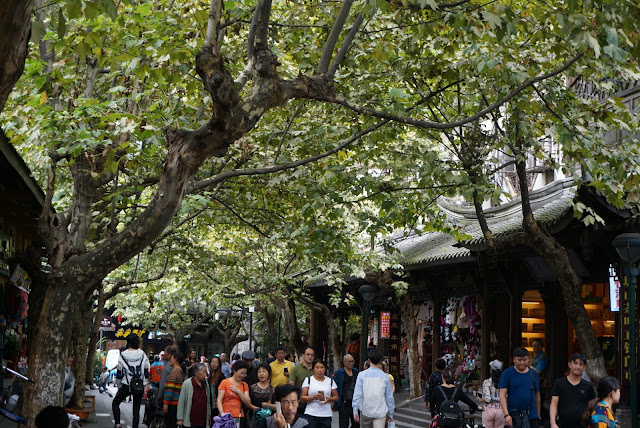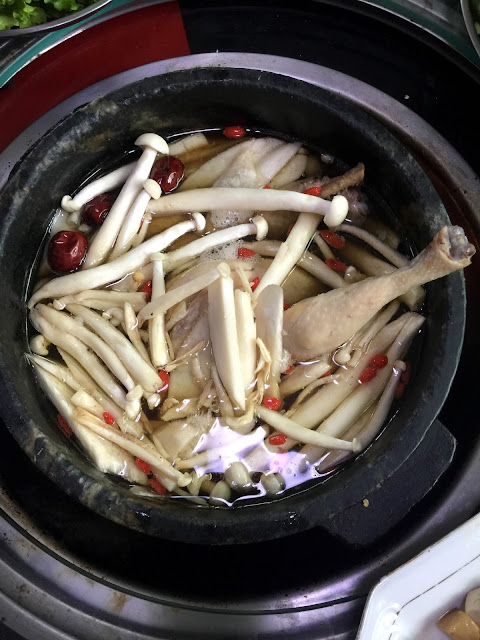DAY 13
After two nights in Nyingchi, we concluded our trip to Tibet and flew back to Chengdu. Our flight out of Nyingchi Airport was in the morning. In less than two hours, we had arrived at Chengdu Airport. Our big tour bus picked us up and we were soon on our way to our lunch spot, South Bridge 南橋. It is a small ancient village near Dujiangyan 都江堰 - the main attraction for our tour this afternoon.
The village is well kept with a quaint ambiance. The main street is paved with paver stones and with well-grown foliage hovering over. It's quite attractive if not for the overly aggressive solicitations from restaurants around.
(Click on each picture to get the full-size view. Some pictures were taken by Ben, Peter, and others without explicit attribution.)
The frontage of the bridge. Its ornate facade and the intricacy of the bridge itself are quite impressive.

There were many eateries lining along the street. We picked the one that seemed to be the busiest. I don't remember the exact names of the food we ordered but they were all tasty. One member of our group, Ben, occupied a seat next to the kitchen. After what he observed how the food was prepared, he said he couldn't eat the food he ordered. We were glad he told us about his experience after we had finished our meal.
Dujiangyan, an ancient irrigation and flood control system still in use today, is a UNESCO World Heritage Site. Unlike other more popular river dam systems that block water, Dujiangyan is a channeling system that diverts river water before it causes flooding in Chengdu.
Our last group picture for the tour.
One of the main constructs of the irrigation and flood control system is called Baopinkou or Bottle-Neck Channel 寶瓶口. It is the third defense of the flood prevention system that diverts just enough water for irrigation.
The second defense of the irrigation and flood control system is called Feishayan or Flying Sand Weir 飛沙堰. It cleverly creates swirling water flow that separates silt and sediment from the water.
The front system of the Dujiangyan irrigation system is called Fish Mouth Levee 魚嘴分水堤. It channels river water to an inner stream for irrigation and flushes out silt and sediment to the outer stream.
Our last dinner as a group was at an authentic Chengdu hot pot restaurant. After this dinner, our Tibet trip officially ended. Our tour guide Titian also bade her farewell to us.
The yin-yan hot pot 鴛鴦鍋. We ordered for the spiciness of the yan part to be mild, but it was still extremely spicy for our untrained palate.
The yin pot had lots of mushrooms.
The all-you-can-scoop condiment counter.
We were divided into three rooms. Every room is filled with joy, happiness, and a little sadness, as we said goodbye to Titian and wished her success in her future endeavor.
The final score of our room - 33 plates of various cuts of meat and some vegetables.
DAY 14
This was our last day in Chengdu. Some had departed last night after our farewell dinner. This morning more departed. Our flight was in the afternoon so we decided to see the panda in the morning. The panda basecamp is in the Chengdu city proper. It was a short taxi ride to get there.
We got there early in the morning, early enough to catch panda's breakfast time. The base camp covers a wide area and it is well maintained.

Super adorable baby pandas.
Sleeping pandas after breakfast.
A very cute and naughty panda.
More bamboo-eating pandas.
A lone giant panda up close.
Panda pair.
There were more than two hundreds pandas in this panda camp. It was one of the most enjoyable experiences of our entire trip. We were so glad we came to see pandas at the last minute.
In the afternoon 18 of us departed from the Chengdu airport. We were flying to Guangzhou to catch a flight back to LA. About 15 minutes before landing at Guangzhou, the pilot announced that because of the weather condition the plane would have to be rerouted to land in Guilin, a city more than 1 hour flight time away. We looked out the window and noticed that there was no sign of bad weather. About 4 hours later when our plane finally flew back to Guangzhou, our flight to LA had departed. Again, we looked around and there was no sign of bad weather. Later we learned that it was common for the airspace in China to be shut down by the Chinese military for no apparent reason. The airlines provided overnight lodging and we took the next day flight back to LA.
This Tibet trip is nothing short of extraordinary. From the initial seemly impossible task of getting the Tibet visa, the long but fascinating bus ride to board the Tibet train, the bucket-list-worthy train ride, the Potala Palace, the unfolding of the secluded inner Tibet, the camaraderie of the group, our impeccable tour guide Titian, and finally the organizing skill of Simon and Philip. We are grateful and blessed to have partaken on this trip.
Now that one more item on the bucket list has been crossed off,
What's next?
Another region that's Chinese,
Or its neighboring Japan, the land of wasabi horseradish,
Or something completely different, such as Spanish?
No matter the location, the logistic, or the scenery,
It's the comradery that we remember and cherish.
Until next time, keep healthy and upbeat,
And stay young at heart like you are still only twenty-three!


















































































